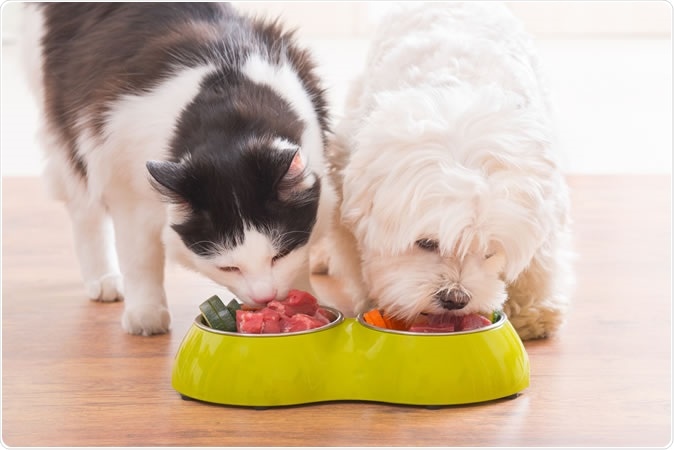Researchers have found in a new study that pet dogs and cats consuming raw meat could be spreading antibiotic resistant bacteria strains to humans. Their study titled, “Raw meat-based diets for companion animals: a potential source of transmission of pathogenic and antimicrobial-resistant Enterobacteriaceae,” was published in the latest issue of Royal Society Open Science this week. The team wrote, “Feeding pets raw meat-based diets (RMBDs) has become increasingly popular but may constitute a risk due to the contamination with pathogenic and antimicrobial-resistant (AMR) bacteria.”

Image Credit: Monika Wisniewska / Shutterstock
There is an alarming rise in antimicrobial resistance and this has stemmed from irrational and indiscriminate use of antibiotics. Some of the bacteria for example are capable of producing certain enzymes that can denature and render ineffective the antibiotics used against them. This makes the pathogen resistant to that particular antibiotic. One such enzyme that can make bacteria resistant to certain antibiotics is called extended spectrum beta-lactamases (EBSL). The ESBL producing bacteria are especially dangerous because they render a large range of antibiotics resistant.
Roger Stephan, professor at the Institute for Food Safety and Hygiene of the Vetsuisse Faculty at the University of Zurich, has explained in his statement, “The situation with the multidrug-resistant bacteria has spiraled out of control in recent years. Urgent measures are needed to tackle the spread of ESBL-producing germs.” To address this question of spread of these organisms, the team of researchers looked at the possible ways in which pets could be transmitting these infections. Vetsuisse Faculty of the UZH found that there were several clinically relevant bacterial strains of bacteria producing ESBL present in pet cats and dogs. Stephan said, “We were concerned that these germs were found so often in dogs and cats. We suspect that diets of raw meat may be a possible source of transmission.”
The team of researchers wrote that mainly dogs are being fed potions of raw meat these days by their owners. They are being fed “BARF” or Biologically Appropriate Raw Food write the researchers. These foods contain portions of raw meat, animal bones and other by products as well as fruits and vegetables. In order to prove that these raw meat based diets could be responsible for bacterial transmission, the team of researchers looked at 51 raw pet food samples obtained from different suppliers in Switzerland. They ascertained the total bacterial load in these foods particularly focussing on Salmonella and normal and antibiotic-resistant enterobacteria.
Results revealed that in 72.5 percent of the samples had enterobacteria that exceeded the recommended limits. Further in 62.7 percent samples there was presence of ESBL-producing bacteria rendering them resistant to the highly powerful and effective antibiotics of the Cephalosporin class.In two cases (3.9 percent) gastroenteritis and typhoid causing Salmonella were also detected. Escherichia coli (E. coli) bacteria containing colistin-resistance gene mcr-1 was also detected. This gene allows the bacteria to be resistant to a powerful antibiotic called Colistin explained the researchers. This gene was recently detected in certain strains in China and is cause for concern. The team wrote, “Colistin- and aminoglycoside-resistant isolates, producing MCR-1 and RMTB, were identified in 3.9 and 2% of the samples, respectively.” Most of these E. coli strains were of commensal groups A or B1 and the team wrote that they were associated with “clonal complexes CC155 and CC10”. These strains were associated with extraintestinal pathogenic CC648 and uropathogenic E. coli sequence type ST6the team explained. This means that the strains of E. coli were responsible for antimicrobial resistant pathogens that caused infections in animals and humans across the world, they wrote.
Magdalena Nüesch-Inderbinen, first author of the study said about the findings, “It is really worrying that we found ESBL-producing bacteria in over 60 percent of the samples. They included several types of E. coli which can cause infections in humans and animals.” She added that BARF diets are a significant risk factor in spreading antibiotic resistant bacteria to animals and humans. Since humans are in contact with their pet foods, the risk of transmission to them is also high says Nüesch-Inderbinen.
Authors of the study wrote in conclusion, “The possibility of transmission of Salmonella and of MDR Enterobacteriaceae from RMBDs to companion animals and their owners poses a severe health risk, particularly to vulnerable persons such as infants, the elderly, pregnant or immunocompromised individuals. Appropriate measures, such as activities that raise the awareness of antimicrobial resistance from the pet food safety perspective and providing information to pet owners on the correct handling of RMBDs, should be established in order to reduce the risk and ensure animal and public health.”
Nüesch-Inderbinen recommended, “We therefore advise all dog and cat owners who want to feed their pets a 'BARF' diet to handle the food carefully and maintain strict hygiene standards. Pet owners should be aware of the risk that their pet may be carrying multidrug-resistant bacteria and can spread them.”
Journal reference:
Raw meat-based diets for companion animals: a potential source of transmission of pathogenic and antimicrobial-resistant Enterobacteriaceae, Magdalena Nüesch-Inderbinen, Andrea Treier, Katrin Zurfluh and Roger Stephan, https://royalsocietypublishing.org/doi/10.1098/rsos.191170